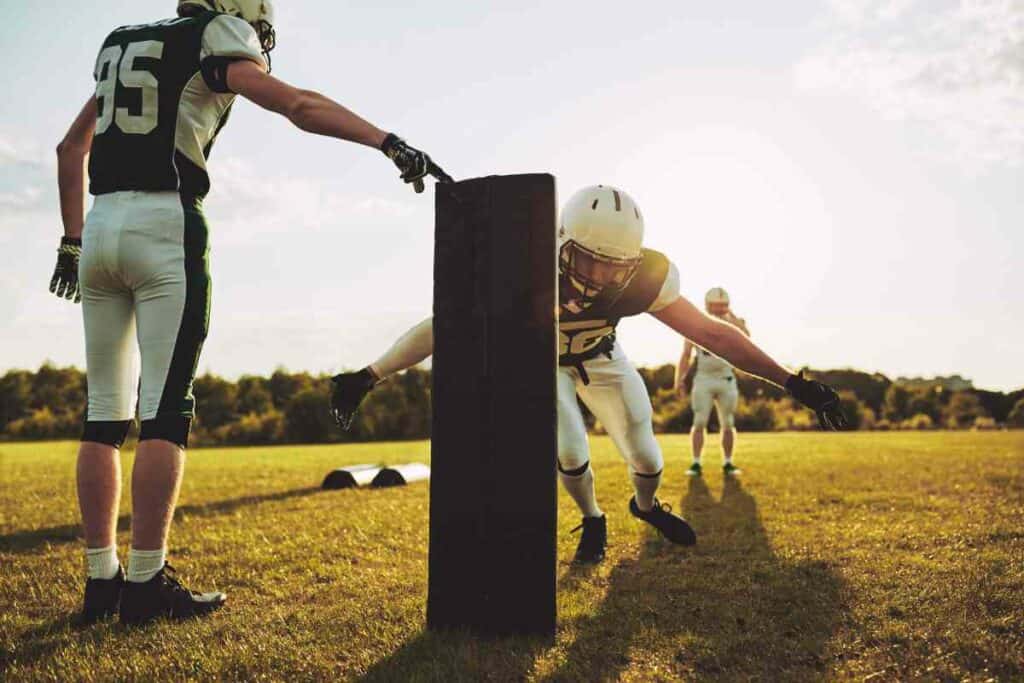How Hard Is It to Walk on a College Football Team?
Starting the journey as a walk-on in college football is a true demonstration of resilience, determination, and passion for the sport. This path is less traveled and marked by stiff competition and substantial commitment. Walk-ons join the team without the promise of playing time or a secured roster spot, distinguishing their journey from that of scholarship athletes and amplifying the challenge of earning a spot on the team.

Related Post! Can You Play College Football Without High School Experience?
How Hard Is It to Walk on a College Football Team?
Walking onto a college football team is highly challenging, requiring exceptional determination, skill, and physical fitness. Prospective walk-ons must stand out in rigorous tryouts, maintain stringent academic standards, and compete against scholarship athletes for a spot. It demands a strong work ethic, time management, and the resilience to face intense competition and scrutiny.
To embark on this challenging path, athletes must not only meet academic standards but also excel athletically, standing out from their peers. Preparation is critical, encompassing skill enhancement, playbook mastery, and achieving optimal physical fitness to catch the coaching staff’s attention. Beyond field performance, understanding the tryout intricacies and managing academic responsibilities underscore the walk-on experience, highlighting the importance of preparedness and mental toughness.
Key Takeaways:
- Walk-ons face formidable obstacles and must exhibit unwavering commitment.
- Detailed preparation is crucial for standing out during tryout sessions.
- Successfully managing academic and athletic commitments is essential for walk-on candidates.
Understanding the Walk-On Experience:
Becoming a walk-on involves navigating a challenging path filled with hard work and tenacity:

What Defines a Walk-On?
Walk-ons are non-scholarship athletes who join college football teams through determination and effort. They lack the financial benefits of their scholarship counterparts and must earn their place:
- Non-Scholarship: No athletic financial aid is provided.
- Open Tryouts: A common route for walk-ons to secure a team spot.
- No Guarantees: Positions on the team must be continually justified.
Types of Walk-On Athletes:
There are primarily two categories of walk-ons, each presenting unique challenges and opportunities:
- Preferred Walk-Ons: These athletes are invited to join the team by the coaching staff, holding a roster spot but not a scholarship.
- Walk-On Tryouts: These individuals must showcase their skills among other non-recruited athletes at open tryouts, competing for a coveted place on the team.
Understanding the hurdles and rewards of being a walk-on is vital. While it is a rigorous path, filled with both physical and mental challenges, it is also a path paved with potential triumphs for those driven by passion and commitment to the game of football.
Related Post! How Old Is The Average College Football Player?
Eligibility and Requirements

Joining a college football team as a walk-on requires understanding and meeting certain eligibility requirements and academic standards. These criteria ensure fair competition and provide a solid academic foundation for student-athletes to succeed in both sports and academics.
Academic Standards for Walk-Ons:
Maintaining high academic standards is crucial for walk-on prospects. This means achieving a specified GPA and fulfilling the course requirements of the intended college or university. While the minimum GPA often hovers around 2.0 on a 4.0 scale, this can vary between institutions.
Typical Academic Requirements:
- GPA: Usually a minimum of 2.0, though specific requirements can differ.
- Coursework: Successful completion of a core curriculum is necessary.
It’s important to verify any additional academic criteria specific to your target school well in advance.
NCAA Eligibility Center Registration:
Becoming eligible to play college football involves registering with the NCAA Eligibility Center, a critical step in confirming your status as an amateur athlete and ensuring academic qualifications are met.
Related Post! How Many College Football Teams Are There?

Steps for Registration:
- Create an Account: Start by setting up a profile on the NCAA Eligibility Center’s website.
- Submit Academic Records: Provide your high school transcripts and standardized test scores.
- Verify Amateur Status: Complete the questionnaire to affirm your amateur athlete status.
Completing these steps puts you on the path to becoming a collegiate walk-on, positioning you to pursue your football aspirations.
Preparation for Walk-On Tryouts:
Preparation is key to transitioning successfully from high school athlete to college football walk-on.

Skill Development:
- Focus on refining position-specific techniques and improving overall game intelligence.
- Regularly engage in drills to enhance passing, tackling, and other relevant skills.
Physical Conditioning:
- Adhere to a rigorous strength and conditioning program.
- Schedule your training to include sprints, agility drills, and endurance exercises throughout the week.
Understanding Playbooks:
- Dedicate time to learn both offensive and defensive schemes.
- Employ mental rehearsals and visualization techniques to better grasp your role and plays.
For aspiring walk-ons, preparation extends beyond the field; it encompasses academic diligence, physical fitness, and mental readiness. With the right approach and commitment, the dream of playing college football can become a reality, even for those without athletic scholarships.
Related Post! Can I Play College Football With A Degree?
The Tryout Process
Walking onto a college football team involves a well-structured approach, starting well before actual tryouts, requiring attention to detail in getting noticed by coaches, understanding the tryout process, and ensuring you make a memorable impact.
Getting Noticed by Coaches:

The initial step involves making yourself visible to the coaching staff. This can be achieved by sending highlight reels and athletic resumes, attending summer camps, and participating in showcase events where you can exhibit your skills directly to college coaches. Consistency and persistence are crucial; keep the coaches updated with your game schedules to encourage them to observe you in action.
Understanding Open Tryouts:
Open tryouts are a critical opportunity to showcase your athleticism and football acumen. Be prepared for:
- 40-yard Dash: Evaluating your speed.
- Pro Agility Shuttle: Testing agility and quickness.
- Bench Press: Measuring upper body strength.
- Vertical Jump: Indicating lower body power.
Preparation is key; mental and physical readiness will help you stand out in these competitive environments. Coaches are looking for more than just talent; they value coachability, teamwork, and adaptability.
Making a Lasting Impression:
Standing out during tryouts is about demonstrating not only physical abilities but also a positive attitude, strong work ethic, and receptiveness to feedback. Show that you are a committed team player, ready to contribute and improve, as these qualities can significantly influence coaches’ decisions.
Challenges and Considerations:
The journey to becoming a walk-on is filled with challenges:
- Balancing Academics and Athletics: Juggling coursework with rigorous training schedules demands excellent time management and dedication.
- Competing for a Spot: You must continually prove your value on the field, outperforming other candidates to secure your position.
- Scholarship Opportunities: While scholarships for walk-ons are rare, exceptional performance can lead to financial support, though it’s a competitive process with no guarantees.
Embracing the role of a walk-on requires a blend of determination, skill, and the ability to manage academic responsibilities alongside athletic commitments. It’s a demanding path but one that can be incredibly rewarding for those with the passion and perseverance to pursue their college football dreams.
